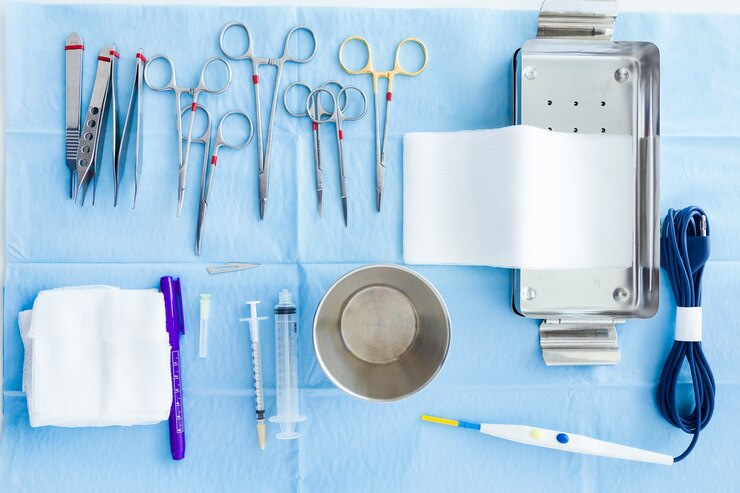Surgical Equipment in African Advancing Healthcare Systems

Understanding the Basics: What is Surgical Equipment?
Surgical equipment refers to the tools and devices used by surgeons and medical practitioners during surgical procedures. These tools range from simple scalpels and forceps to complex machines like ventilators and anesthesia systems. Without these essential items, performing surgery becomes nearly impossible, putting patients at risk.
Types of Surgical Equipment
- Basic Tools: Instruments like scalpels, scissors, and forceps that are used in almost every surgical procedure.
- Diagnostic Equipment: Tools like endoscopes that help in diagnosing conditions before surgery.
- Monitoring Devices: Equipment like ECG machines that monitor the patient’s vital signs during surgery.
- Advanced Machines: Devices like surgical robots that assist in complex procedures.
Each of these tools has a specific role in ensuring that surgeries are performed safely and effectively.
The Current State of Healthcare in Africa
Before diving into the specifics of Surgical Equipments in Africa, it’s essential to understand the broader context of healthcare in Africa. The continent faces unique challenges, including a high burden of infectious diseases, limited healthcare infrastructure, and a shortage of healthcare professionals. These issues are compounded by the lack of access to essential surgical equipment.
Healthcare Disparities
In many African countries, there is a significant disparity in healthcare access between urban and rural areas. While cities may have well-equipped hospitals, rural regions often rely on under-resourced clinics. This disparity means that many people in need of surgery are either unable to receive it or must travel long distances to access care.
Why Surgical Equipment is Essential for Healthcare
Surgical equipment is more than just a collection of tools; it is an integral part of the healthcare system. Without it, many medical interventions would be impossible, leading to higher mortality rates and poorer health outcomes.
Saving Lives
Surgical procedures, whether routine or complex, are often life-saving. From cesarean sections to remove an appendix, surgeries rely on precise instruments to be successful. Without these tools, even the most skilled surgeons would be powerless to help their patients.
Improving Quality of Life
Beyond saving lives, surgical equipment also plays a crucial role in improving the quality of life. Surgeries to correct vision, repair fractures, or remove tumors can drastically change a patient’s life for the better. Access to the right equipment makes these outcomes possible.
Common Surgical Procedures in Africa
In Africa, certain Surgical Equipments in Africa procedures are more common due to the specific health challenges faced by the population. These include:
Cesarean Sections
Maternal and child health is a significant concern in Africa, where complications during childbirth are common. Cesarean sections are often necessary to save the lives of both mother and child, making surgical equipment essential in maternity wards.
Trauma Surgery
With high rates of road traffic accidents and injuries from conflicts, trauma surgery is another critical area where surgical equipment is vital. Surgeons need reliable tools to address fractures, internal bleeding, and other severe injuries.
Infectious Disease Surgery
Diseases like tuberculosis and HIV/AIDS can lead to complications that require surgical intervention. For example, abscesses and other infections may need to be drained surgically, necessitating the availability of appropriate equipment.
Challenges in Accessing Surgical Equipment in Africa
Despite the clear need for surgical equipment, many African countries face significant challenges in accessing these critical tools.
High Costs
One of the most significant barriers is the cost of surgical equipment. Many African countries operate on limited healthcare budgets, making it difficult to afford the latest and most effective tools.
Supply Chain Issues
Even when funds are available, getting equipment to where it is needed can be challenging. Poor infrastructure, political instability, and logistical challenges often delay or prevent the delivery of surgical tools to healthcare facilities.
Training and Maintenance
Having the equipment is only part of the solution. Healthcare professionals need training to use these tools effectively, and regular maintenance is required to keep them in working order. Both of these aspects are often lacking in resource-constrained settings.
Innovations in Surgical Equipment: A Game-Changer
Despite the challenges, there have been significant innovations in surgical equipment that are making a difference in African healthcare systems.
Portable Surgical Kits
One innovation that has had a profound impact is the development of portable surgical kits. These kits contain all the essential tools needed for basic surgeries and can be easily transported to remote areas. They are particularly useful in regions where there is no access to fully equipped hospitals.
Low-Cost Equipment
There is also a growing market for low-cost surgical equipment designed specifically for use in low-resource settings. These tools are often simpler and more durable, making them ideal for the challenging conditions in many African healthcare facilities.
Telemedicine and Remote Surgery
Advances in telemedicine are also helping to bridge the gap. Surgeons in well-equipped hospitals can now guide less experienced colleagues in remote areas through complex procedures using video conferencing and other technologies. This approach allows for better utilization of available resources and improves patient outcomes.
Case Studies: Impact of Surgical Equipment in African Hospitals
To understand the real-world impact of surgical equipment, let’s look at a few case studies from hospitals across Africa.
Kenya: Transforming Maternal Health
In Kenya, the introduction of portable surgical kits in rural clinics has significantly reduced maternal and infant mortality rates. These kits have enabled healthcare workers to perform life-saving cesarean sections and other emergency procedures without needing to transfer patients to distant hospitals Surgical Equipments in Africa.
South Africa: Tackling Trauma
South Africa has one of the highest rates of road traffic accidents in the world. In response, hospitals have invested in advanced trauma surgery equipment, which has helped to save countless lives. The availability of these tools has also reduced the long-term disability rates associated with severe injuries.
Uganda: Fighting Infectious Diseases
In Uganda, where tuberculosis is a major health challenge, the availability of specialized surgical equipment has been crucial in treating complications related to the disease. Hospitals equipped with these tools have been able to perform surgeries that prevent the spread of infection and improve patient recovery times.
The Role of International Aid and Partnerships
International aid organizations and partnerships have played a significant role in improving access to surgical equipment in Africa.
Donations and Funding
Many hospitals in Africa rely on donations of surgical equipment from international organizations. These donations have been instrumental in filling the gaps in healthcare systems that lack the resources to purchase new tools.
Training Programs
In addition to providing equipment, many international partnerships focus on training healthcare professionals. These programs ensure that doctors and nurses are equipped with the skills they need to use the donated tools effectively.
Local Manufacturing: A Solution to Equipment Shortages?
One potential solution to the shortage of surgical equipment in Africa is to increase local manufacturing. By producing equipment within the continent, it would be possible to reduce costs and improve access.
Economic Benefits
Local manufacturing could also provide economic benefits by creating jobs and reducing reliance on imports. This approach would help to build more sustainable healthcare systems in the long term.
Challenges to Implementation
However, there are challenges to implementing local manufacturing, including the need for technical expertise and initial investment. Governments and private sector partners would need to work together to overcome these obstacles.
The Future of Surgical Equipment in Africa
Looking ahead, the future of Surgical Equipments in Africa is promising. With continued innovation, increased local production, and ongoing support from international partners, it is possible to envision a future where every African hospital is equipped with the tools it needs to provide high-quality surgical care.
Empowering Healthcare Systems
The ultimate goal is to empower African healthcare systems to provide better care for their populations. By addressing the challenges related to surgical equipment, we can move closer to achieving this goal.








